Competition Law's Impact on Intellectual Property Rights
VerifiedAdded on 2020/05/11
|14
|3812
|82
Report
AI Summary
This report examines the relationship between competition law and intellectual property rights, focusing on how competition law regulates and interacts with intellectual property. It begins with an introduction to the topic, explaining the importance of intellectual property rights in encouraging innovation and investment, and then discusses potential conflicts with competition law principles. The report explores key competition issues, including technology licensing and its pro-competitive effects, as well as potential anti-competitive arrangements. It then delves into the relevant EU competition law provisions, specifically Articles 101 and 102 of the TFEU, outlining the prohibitions and the jurisdictional considerations. The report analyzes the application of Article 101, including the evaluation process for licensing agreements. It then examines the impact of recent decisions on the application of these laws, highlighting the limitations placed on IP rights owners and the importance of maintaining effective competition. The report discusses exclusionary powers, including the circumstances under which the exercise of these powers may be deemed anti-competitive, and concludes with an overview of the key findings.
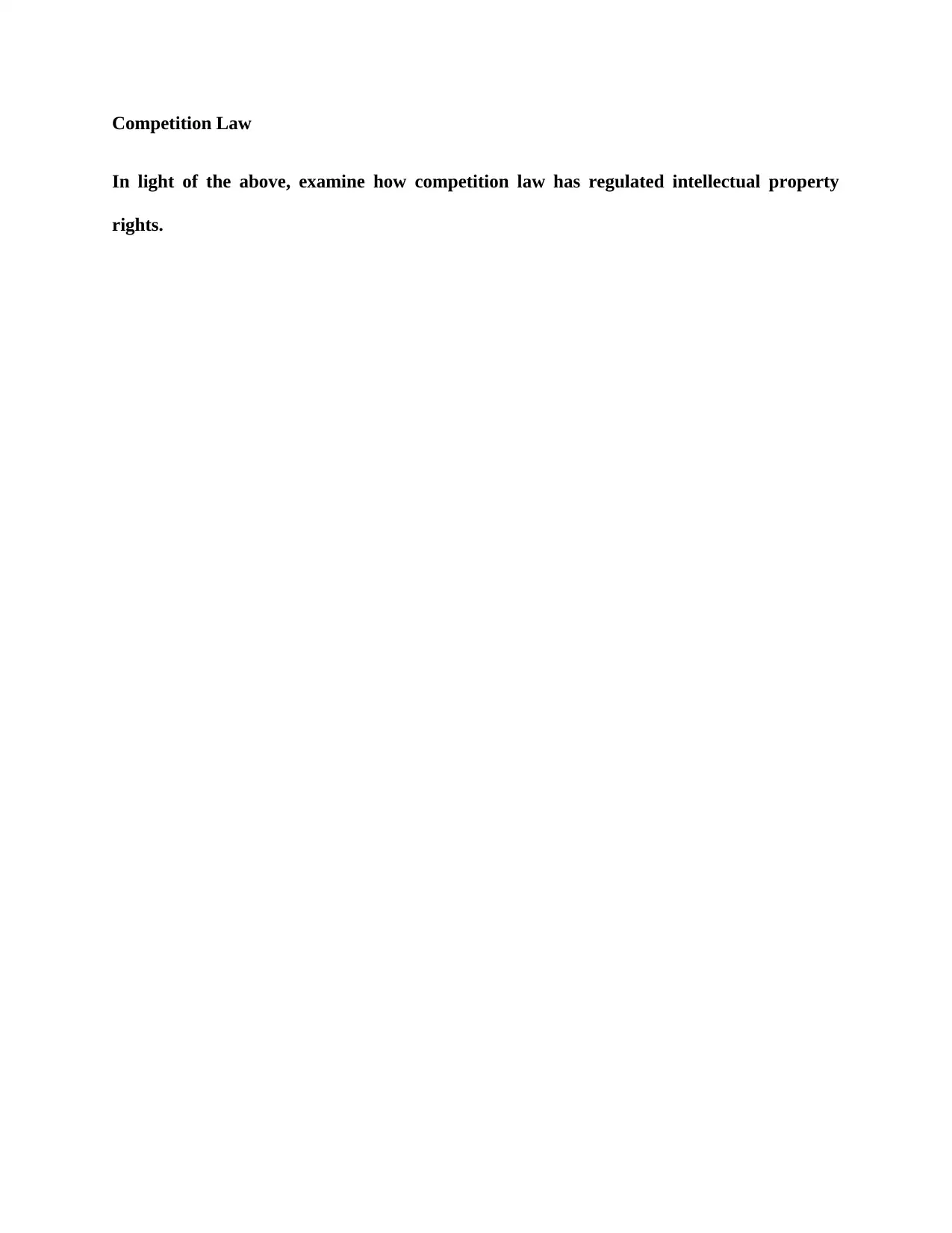
Competition Law
In light of the above, examine how competition law has regulated intellectual property
rights.
In light of the above, examine how competition law has regulated intellectual property
rights.
Paraphrase This Document
Need a fresh take? Get an instant paraphrase of this document with our AI Paraphraser
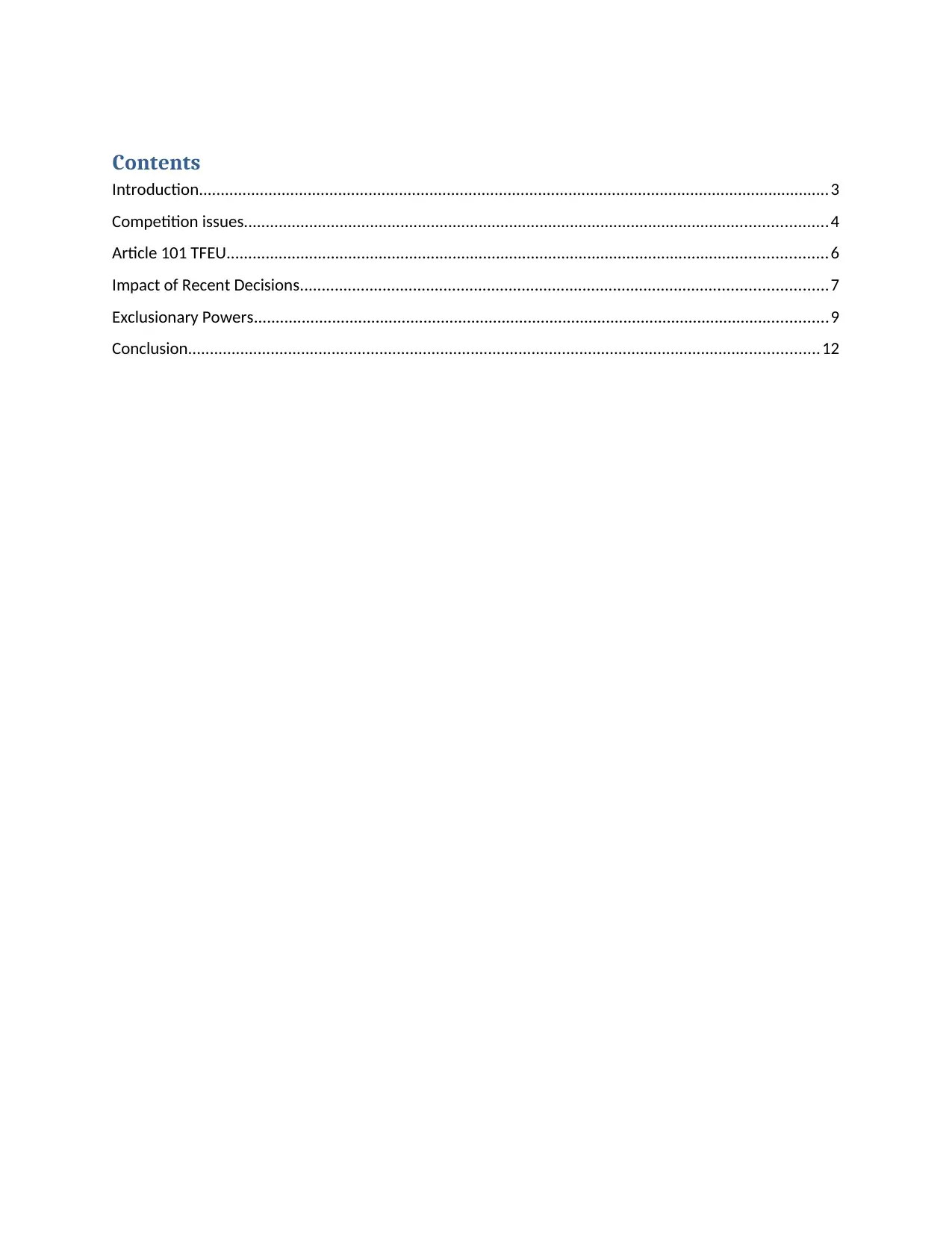
Contents
Introduction.................................................................................................................................................3
Competition issues......................................................................................................................................4
Article 101 TFEU..........................................................................................................................................6
Impact of Recent Decisions.........................................................................................................................7
Exclusionary Powers....................................................................................................................................9
Conclusion.................................................................................................................................................12
Introduction.................................................................................................................................................3
Competition issues......................................................................................................................................4
Article 101 TFEU..........................................................................................................................................6
Impact of Recent Decisions.........................................................................................................................7
Exclusionary Powers....................................................................................................................................9
Conclusion.................................................................................................................................................12
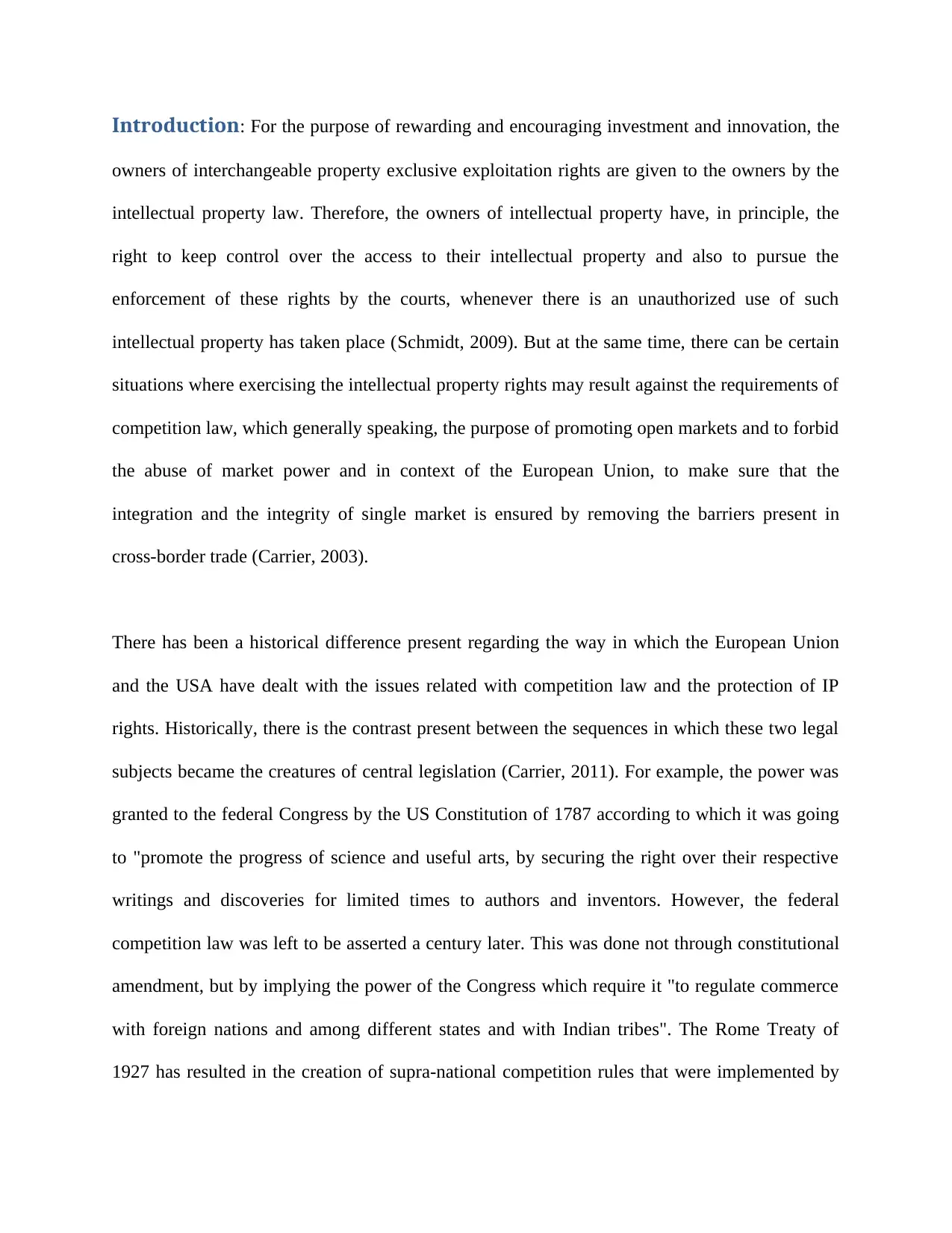
Introduction: For the purpose of rewarding and encouraging investment and innovation, the
owners of interchangeable property exclusive exploitation rights are given to the owners by the
intellectual property law. Therefore, the owners of intellectual property have, in principle, the
right to keep control over the access to their intellectual property and also to pursue the
enforcement of these rights by the courts, whenever there is an unauthorized use of such
intellectual property has taken place (Schmidt, 2009). But at the same time, there can be certain
situations where exercising the intellectual property rights may result against the requirements of
competition law, which generally speaking, the purpose of promoting open markets and to forbid
the abuse of market power and in context of the European Union, to make sure that the
integration and the integrity of single market is ensured by removing the barriers present in
cross-border trade (Carrier, 2003).
There has been a historical difference present regarding the way in which the European Union
and the USA have dealt with the issues related with competition law and the protection of IP
rights. Historically, there is the contrast present between the sequences in which these two legal
subjects became the creatures of central legislation (Carrier, 2011). For example, the power was
granted to the federal Congress by the US Constitution of 1787 according to which it was going
to "promote the progress of science and useful arts, by securing the right over their respective
writings and discoveries for limited times to authors and inventors. However, the federal
competition law was left to be asserted a century later. This was done not through constitutional
amendment, but by implying the power of the Congress which require it "to regulate commerce
with foreign nations and among different states and with Indian tribes". The Rome Treaty of
1927 has resulted in the creation of supra-national competition rules that were implemented by
owners of interchangeable property exclusive exploitation rights are given to the owners by the
intellectual property law. Therefore, the owners of intellectual property have, in principle, the
right to keep control over the access to their intellectual property and also to pursue the
enforcement of these rights by the courts, whenever there is an unauthorized use of such
intellectual property has taken place (Schmidt, 2009). But at the same time, there can be certain
situations where exercising the intellectual property rights may result against the requirements of
competition law, which generally speaking, the purpose of promoting open markets and to forbid
the abuse of market power and in context of the European Union, to make sure that the
integration and the integrity of single market is ensured by removing the barriers present in
cross-border trade (Carrier, 2003).
There has been a historical difference present regarding the way in which the European Union
and the USA have dealt with the issues related with competition law and the protection of IP
rights. Historically, there is the contrast present between the sequences in which these two legal
subjects became the creatures of central legislation (Carrier, 2011). For example, the power was
granted to the federal Congress by the US Constitution of 1787 according to which it was going
to "promote the progress of science and useful arts, by securing the right over their respective
writings and discoveries for limited times to authors and inventors. However, the federal
competition law was left to be asserted a century later. This was done not through constitutional
amendment, but by implying the power of the Congress which require it "to regulate commerce
with foreign nations and among different states and with Indian tribes". The Rome Treaty of
1927 has resulted in the creation of supra-national competition rules that were implemented by
⊘ This is a preview!⊘
Do you want full access?
Subscribe today to unlock all pages.

Trusted by 1+ million students worldwide
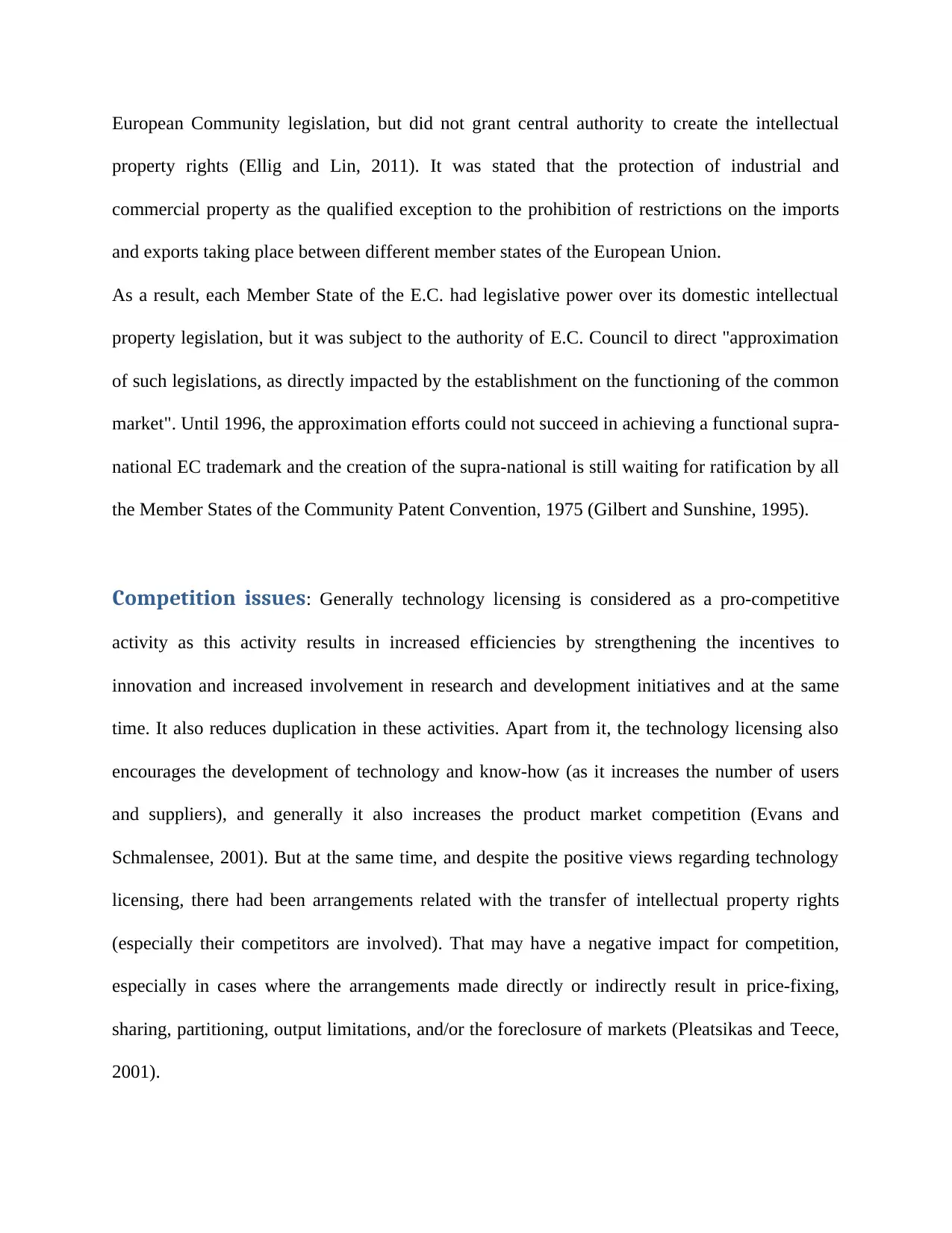
European Community legislation, but did not grant central authority to create the intellectual
property rights (Ellig and Lin, 2011). It was stated that the protection of industrial and
commercial property as the qualified exception to the prohibition of restrictions on the imports
and exports taking place between different member states of the European Union.
As a result, each Member State of the E.C. had legislative power over its domestic intellectual
property legislation, but it was subject to the authority of E.C. Council to direct "approximation
of such legislations, as directly impacted by the establishment on the functioning of the common
market". Until 1996, the approximation efforts could not succeed in achieving a functional supra-
national EC trademark and the creation of the supra-national is still waiting for ratification by all
the Member States of the Community Patent Convention, 1975 (Gilbert and Sunshine, 1995).
Competition issues: Generally technology licensing is considered as a pro-competitive
activity as this activity results in increased efficiencies by strengthening the incentives to
innovation and increased involvement in research and development initiatives and at the same
time. It also reduces duplication in these activities. Apart from it, the technology licensing also
encourages the development of technology and know-how (as it increases the number of users
and suppliers), and generally it also increases the product market competition (Evans and
Schmalensee, 2001). But at the same time, and despite the positive views regarding technology
licensing, there had been arrangements related with the transfer of intellectual property rights
(especially their competitors are involved). That may have a negative impact for competition,
especially in cases where the arrangements made directly or indirectly result in price-fixing,
sharing, partitioning, output limitations, and/or the foreclosure of markets (Pleatsikas and Teece,
2001).
property rights (Ellig and Lin, 2011). It was stated that the protection of industrial and
commercial property as the qualified exception to the prohibition of restrictions on the imports
and exports taking place between different member states of the European Union.
As a result, each Member State of the E.C. had legislative power over its domestic intellectual
property legislation, but it was subject to the authority of E.C. Council to direct "approximation
of such legislations, as directly impacted by the establishment on the functioning of the common
market". Until 1996, the approximation efforts could not succeed in achieving a functional supra-
national EC trademark and the creation of the supra-national is still waiting for ratification by all
the Member States of the Community Patent Convention, 1975 (Gilbert and Sunshine, 1995).
Competition issues: Generally technology licensing is considered as a pro-competitive
activity as this activity results in increased efficiencies by strengthening the incentives to
innovation and increased involvement in research and development initiatives and at the same
time. It also reduces duplication in these activities. Apart from it, the technology licensing also
encourages the development of technology and know-how (as it increases the number of users
and suppliers), and generally it also increases the product market competition (Evans and
Schmalensee, 2001). But at the same time, and despite the positive views regarding technology
licensing, there had been arrangements related with the transfer of intellectual property rights
(especially their competitors are involved). That may have a negative impact for competition,
especially in cases where the arrangements made directly or indirectly result in price-fixing,
sharing, partitioning, output limitations, and/or the foreclosure of markets (Pleatsikas and Teece,
2001).
Paraphrase This Document
Need a fresh take? Get an instant paraphrase of this document with our AI Paraphraser
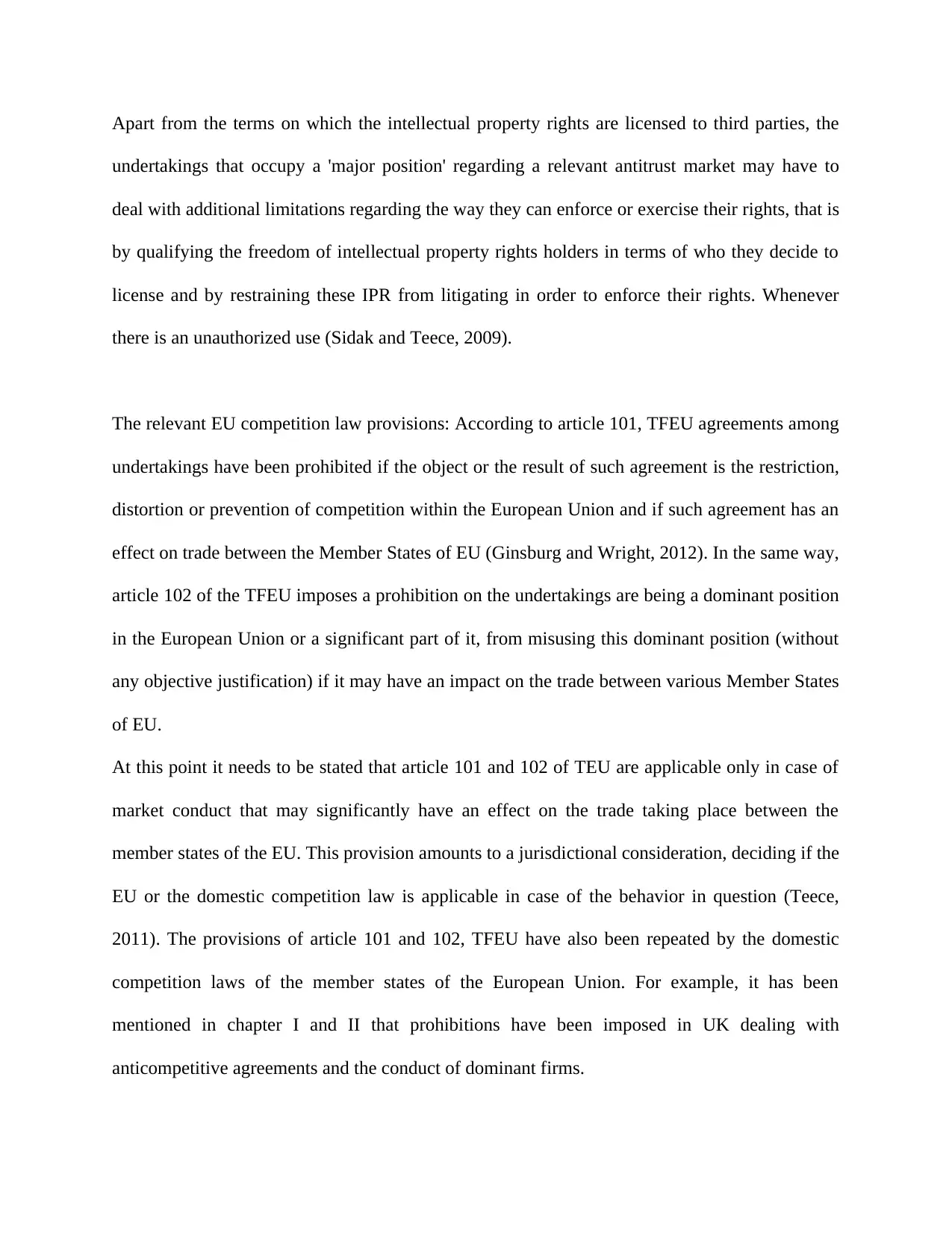
Apart from the terms on which the intellectual property rights are licensed to third parties, the
undertakings that occupy a 'major position' regarding a relevant antitrust market may have to
deal with additional limitations regarding the way they can enforce or exercise their rights, that is
by qualifying the freedom of intellectual property rights holders in terms of who they decide to
license and by restraining these IPR from litigating in order to enforce their rights. Whenever
there is an unauthorized use (Sidak and Teece, 2009).
The relevant EU competition law provisions: According to article 101, TFEU agreements among
undertakings have been prohibited if the object or the result of such agreement is the restriction,
distortion or prevention of competition within the European Union and if such agreement has an
effect on trade between the Member States of EU (Ginsburg and Wright, 2012). In the same way,
article 102 of the TFEU imposes a prohibition on the undertakings are being a dominant position
in the European Union or a significant part of it, from misusing this dominant position (without
any objective justification) if it may have an impact on the trade between various Member States
of EU.
At this point it needs to be stated that article 101 and 102 of TEU are applicable only in case of
market conduct that may significantly have an effect on the trade taking place between the
member states of the EU. This provision amounts to a jurisdictional consideration, deciding if the
EU or the domestic competition law is applicable in case of the behavior in question (Teece,
2011). The provisions of article 101 and 102, TFEU have also been repeated by the domestic
competition laws of the member states of the European Union. For example, it has been
mentioned in chapter I and II that prohibitions have been imposed in UK dealing with
anticompetitive agreements and the conduct of dominant firms.
undertakings that occupy a 'major position' regarding a relevant antitrust market may have to
deal with additional limitations regarding the way they can enforce or exercise their rights, that is
by qualifying the freedom of intellectual property rights holders in terms of who they decide to
license and by restraining these IPR from litigating in order to enforce their rights. Whenever
there is an unauthorized use (Sidak and Teece, 2009).
The relevant EU competition law provisions: According to article 101, TFEU agreements among
undertakings have been prohibited if the object or the result of such agreement is the restriction,
distortion or prevention of competition within the European Union and if such agreement has an
effect on trade between the Member States of EU (Ginsburg and Wright, 2012). In the same way,
article 102 of the TFEU imposes a prohibition on the undertakings are being a dominant position
in the European Union or a significant part of it, from misusing this dominant position (without
any objective justification) if it may have an impact on the trade between various Member States
of EU.
At this point it needs to be stated that article 101 and 102 of TEU are applicable only in case of
market conduct that may significantly have an effect on the trade taking place between the
member states of the EU. This provision amounts to a jurisdictional consideration, deciding if the
EU or the domestic competition law is applicable in case of the behavior in question (Teece,
2011). The provisions of article 101 and 102, TFEU have also been repeated by the domestic
competition laws of the member states of the European Union. For example, it has been
mentioned in chapter I and II that prohibitions have been imposed in UK dealing with
anticompetitive agreements and the conduct of dominant firms.
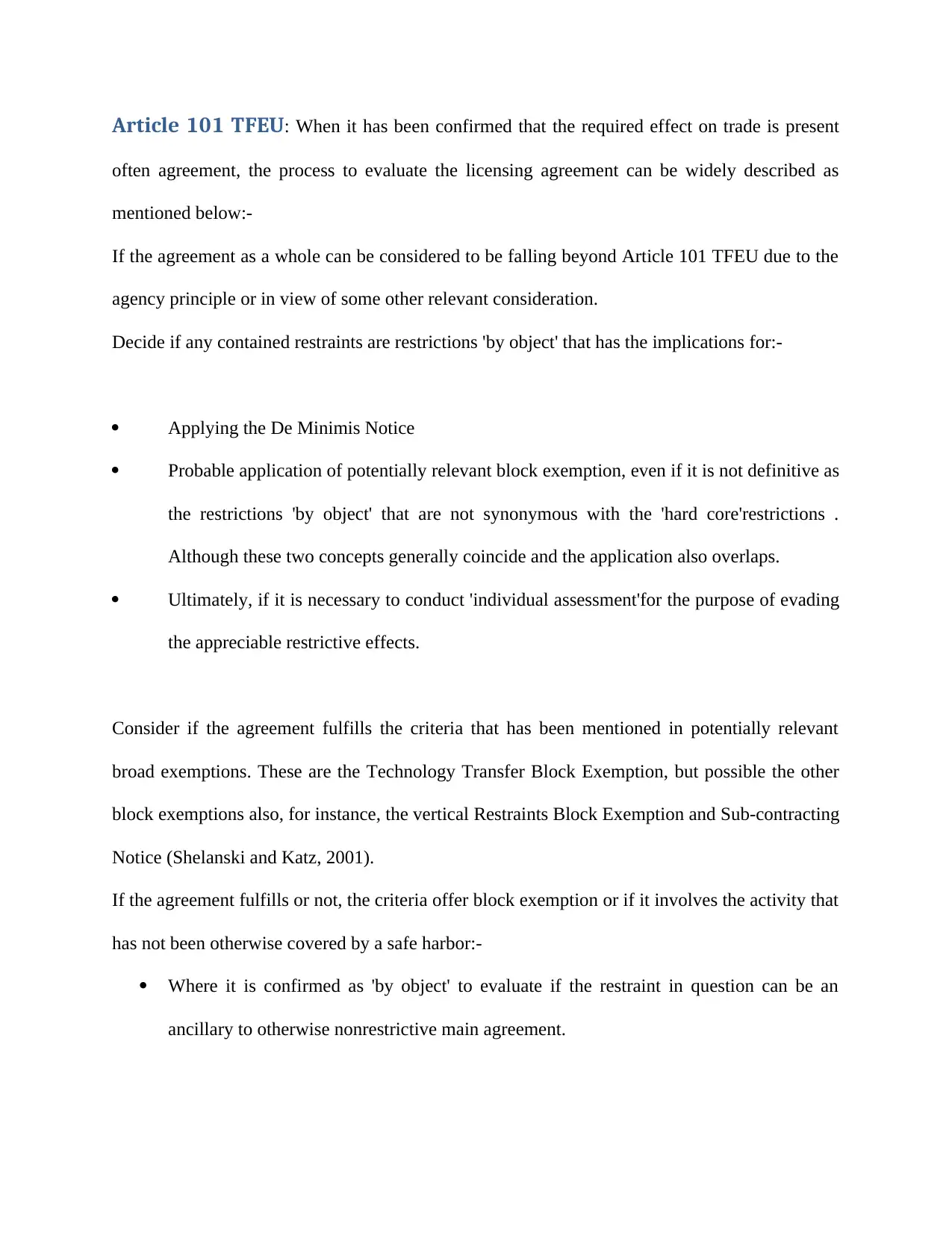
Article 101 TFEU: When it has been confirmed that the required effect on trade is present
often agreement, the process to evaluate the licensing agreement can be widely described as
mentioned below:-
If the agreement as a whole can be considered to be falling beyond Article 101 TFEU due to the
agency principle or in view of some other relevant consideration.
Decide if any contained restraints are restrictions 'by object' that has the implications for:-
Applying the De Minimis Notice
Probable application of potentially relevant block exemption, even if it is not definitive as
the restrictions 'by object' that are not synonymous with the 'hard core'restrictions .
Although these two concepts generally coincide and the application also overlaps.
Ultimately, if it is necessary to conduct 'individual assessment'for the purpose of evading
the appreciable restrictive effects.
Consider if the agreement fulfills the criteria that has been mentioned in potentially relevant
broad exemptions. These are the Technology Transfer Block Exemption, but possible the other
block exemptions also, for instance, the vertical Restraints Block Exemption and Sub-contracting
Notice (Shelanski and Katz, 2001).
If the agreement fulfills or not, the criteria offer block exemption or if it involves the activity that
has not been otherwise covered by a safe harbor:-
Where it is confirmed as 'by object' to evaluate if the restraint in question can be an
ancillary to otherwise nonrestrictive main agreement.
often agreement, the process to evaluate the licensing agreement can be widely described as
mentioned below:-
If the agreement as a whole can be considered to be falling beyond Article 101 TFEU due to the
agency principle or in view of some other relevant consideration.
Decide if any contained restraints are restrictions 'by object' that has the implications for:-
Applying the De Minimis Notice
Probable application of potentially relevant block exemption, even if it is not definitive as
the restrictions 'by object' that are not synonymous with the 'hard core'restrictions .
Although these two concepts generally coincide and the application also overlaps.
Ultimately, if it is necessary to conduct 'individual assessment'for the purpose of evading
the appreciable restrictive effects.
Consider if the agreement fulfills the criteria that has been mentioned in potentially relevant
broad exemptions. These are the Technology Transfer Block Exemption, but possible the other
block exemptions also, for instance, the vertical Restraints Block Exemption and Sub-contracting
Notice (Shelanski and Katz, 2001).
If the agreement fulfills or not, the criteria offer block exemption or if it involves the activity that
has not been otherwise covered by a safe harbor:-
Where it is confirmed as 'by object' to evaluate if the restraint in question can be an
ancillary to otherwise nonrestrictive main agreement.
⊘ This is a preview!⊘
Do you want full access?
Subscribe today to unlock all pages.

Trusted by 1+ million students worldwide
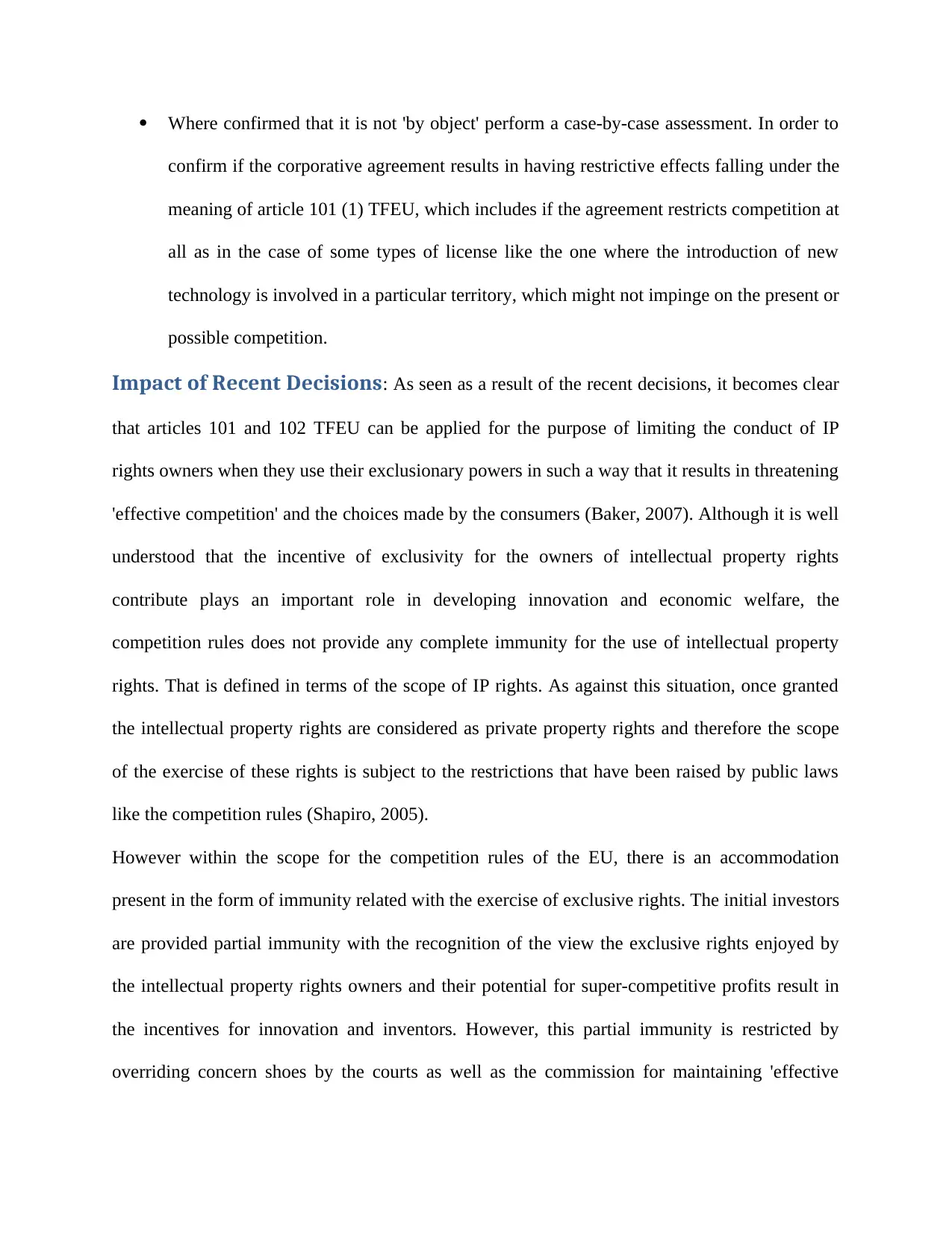
Where confirmed that it is not 'by object' perform a case-by-case assessment. In order to
confirm if the corporative agreement results in having restrictive effects falling under the
meaning of article 101 (1) TFEU, which includes if the agreement restricts competition at
all as in the case of some types of license like the one where the introduction of new
technology is involved in a particular territory, which might not impinge on the present or
possible competition.
Impact of Recent Decisions: As seen as a result of the recent decisions, it becomes clear
that articles 101 and 102 TFEU can be applied for the purpose of limiting the conduct of IP
rights owners when they use their exclusionary powers in such a way that it results in threatening
'effective competition' and the choices made by the consumers (Baker, 2007). Although it is well
understood that the incentive of exclusivity for the owners of intellectual property rights
contribute plays an important role in developing innovation and economic welfare, the
competition rules does not provide any complete immunity for the use of intellectual property
rights. That is defined in terms of the scope of IP rights. As against this situation, once granted
the intellectual property rights are considered as private property rights and therefore the scope
of the exercise of these rights is subject to the restrictions that have been raised by public laws
like the competition rules (Shapiro, 2005).
However within the scope for the competition rules of the EU, there is an accommodation
present in the form of immunity related with the exercise of exclusive rights. The initial investors
are provided partial immunity with the recognition of the view the exclusive rights enjoyed by
the intellectual property rights owners and their potential for super-competitive profits result in
the incentives for innovation and inventors. However, this partial immunity is restricted by
overriding concern shoes by the courts as well as the commission for maintaining 'effective
confirm if the corporative agreement results in having restrictive effects falling under the
meaning of article 101 (1) TFEU, which includes if the agreement restricts competition at
all as in the case of some types of license like the one where the introduction of new
technology is involved in a particular territory, which might not impinge on the present or
possible competition.
Impact of Recent Decisions: As seen as a result of the recent decisions, it becomes clear
that articles 101 and 102 TFEU can be applied for the purpose of limiting the conduct of IP
rights owners when they use their exclusionary powers in such a way that it results in threatening
'effective competition' and the choices made by the consumers (Baker, 2007). Although it is well
understood that the incentive of exclusivity for the owners of intellectual property rights
contribute plays an important role in developing innovation and economic welfare, the
competition rules does not provide any complete immunity for the use of intellectual property
rights. That is defined in terms of the scope of IP rights. As against this situation, once granted
the intellectual property rights are considered as private property rights and therefore the scope
of the exercise of these rights is subject to the restrictions that have been raised by public laws
like the competition rules (Shapiro, 2005).
However within the scope for the competition rules of the EU, there is an accommodation
present in the form of immunity related with the exercise of exclusive rights. The initial investors
are provided partial immunity with the recognition of the view the exclusive rights enjoyed by
the intellectual property rights owners and their potential for super-competitive profits result in
the incentives for innovation and inventors. However, this partial immunity is restricted by
overriding concern shoes by the courts as well as the commission for maintaining 'effective
Paraphrase This Document
Need a fresh take? Get an instant paraphrase of this document with our AI Paraphraser
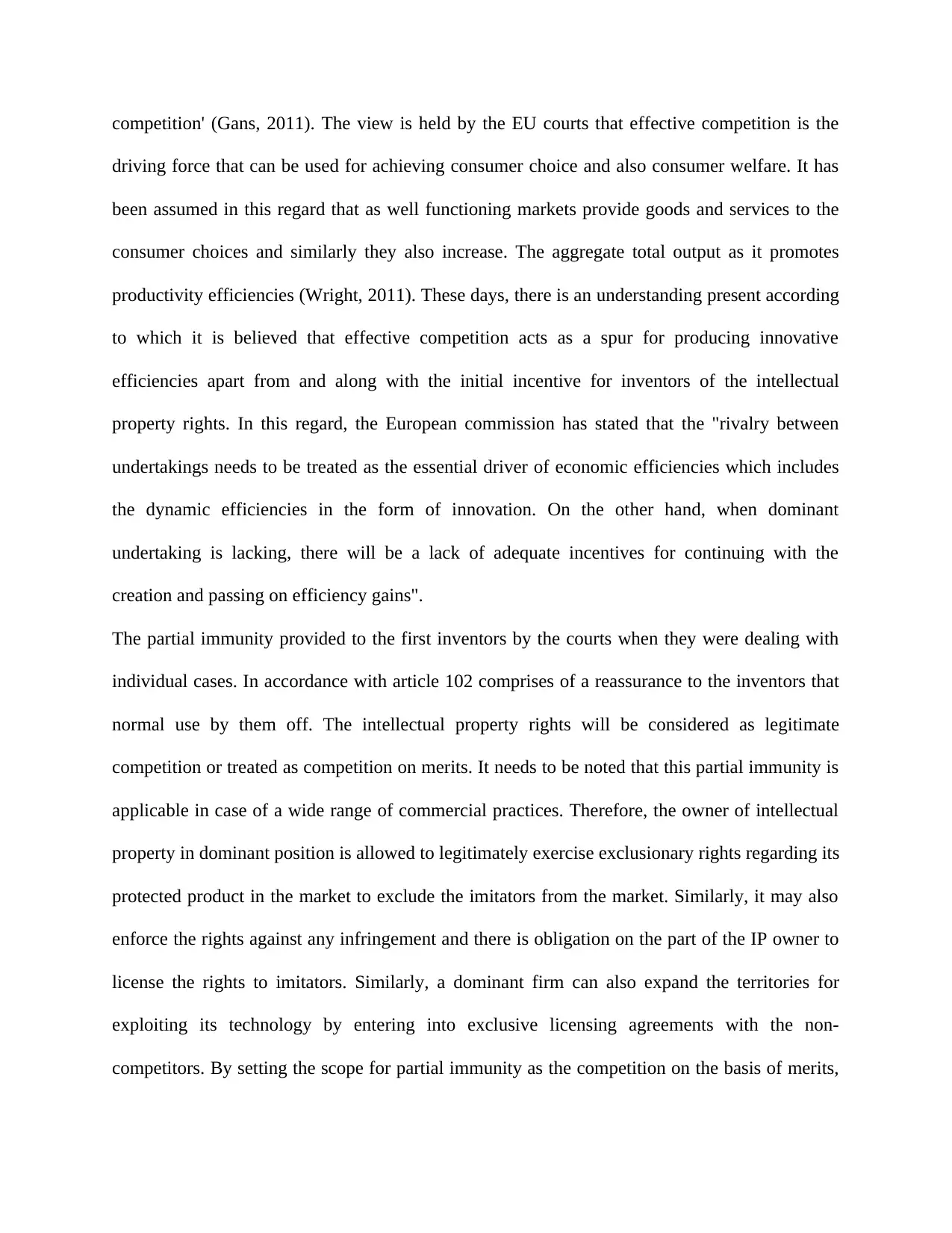
competition' (Gans, 2011). The view is held by the EU courts that effective competition is the
driving force that can be used for achieving consumer choice and also consumer welfare. It has
been assumed in this regard that as well functioning markets provide goods and services to the
consumer choices and similarly they also increase. The aggregate total output as it promotes
productivity efficiencies (Wright, 2011). These days, there is an understanding present according
to which it is believed that effective competition acts as a spur for producing innovative
efficiencies apart from and along with the initial incentive for inventors of the intellectual
property rights. In this regard, the European commission has stated that the "rivalry between
undertakings needs to be treated as the essential driver of economic efficiencies which includes
the dynamic efficiencies in the form of innovation. On the other hand, when dominant
undertaking is lacking, there will be a lack of adequate incentives for continuing with the
creation and passing on efficiency gains".
The partial immunity provided to the first inventors by the courts when they were dealing with
individual cases. In accordance with article 102 comprises of a reassurance to the inventors that
normal use by them off. The intellectual property rights will be considered as legitimate
competition or treated as competition on merits. It needs to be noted that this partial immunity is
applicable in case of a wide range of commercial practices. Therefore, the owner of intellectual
property in dominant position is allowed to legitimately exercise exclusionary rights regarding its
protected product in the market to exclude the imitators from the market. Similarly, it may also
enforce the rights against any infringement and there is obligation on the part of the IP owner to
license the rights to imitators. Similarly, a dominant firm can also expand the territories for
exploiting its technology by entering into exclusive licensing agreements with the non-
competitors. By setting the scope for partial immunity as the competition on the basis of merits,
driving force that can be used for achieving consumer choice and also consumer welfare. It has
been assumed in this regard that as well functioning markets provide goods and services to the
consumer choices and similarly they also increase. The aggregate total output as it promotes
productivity efficiencies (Wright, 2011). These days, there is an understanding present according
to which it is believed that effective competition acts as a spur for producing innovative
efficiencies apart from and along with the initial incentive for inventors of the intellectual
property rights. In this regard, the European commission has stated that the "rivalry between
undertakings needs to be treated as the essential driver of economic efficiencies which includes
the dynamic efficiencies in the form of innovation. On the other hand, when dominant
undertaking is lacking, there will be a lack of adequate incentives for continuing with the
creation and passing on efficiency gains".
The partial immunity provided to the first inventors by the courts when they were dealing with
individual cases. In accordance with article 102 comprises of a reassurance to the inventors that
normal use by them off. The intellectual property rights will be considered as legitimate
competition or treated as competition on merits. It needs to be noted that this partial immunity is
applicable in case of a wide range of commercial practices. Therefore, the owner of intellectual
property in dominant position is allowed to legitimately exercise exclusionary rights regarding its
protected product in the market to exclude the imitators from the market. Similarly, it may also
enforce the rights against any infringement and there is obligation on the part of the IP owner to
license the rights to imitators. Similarly, a dominant firm can also expand the territories for
exploiting its technology by entering into exclusive licensing agreements with the non-
competitors. By setting the scope for partial immunity as the competition on the basis of merits,
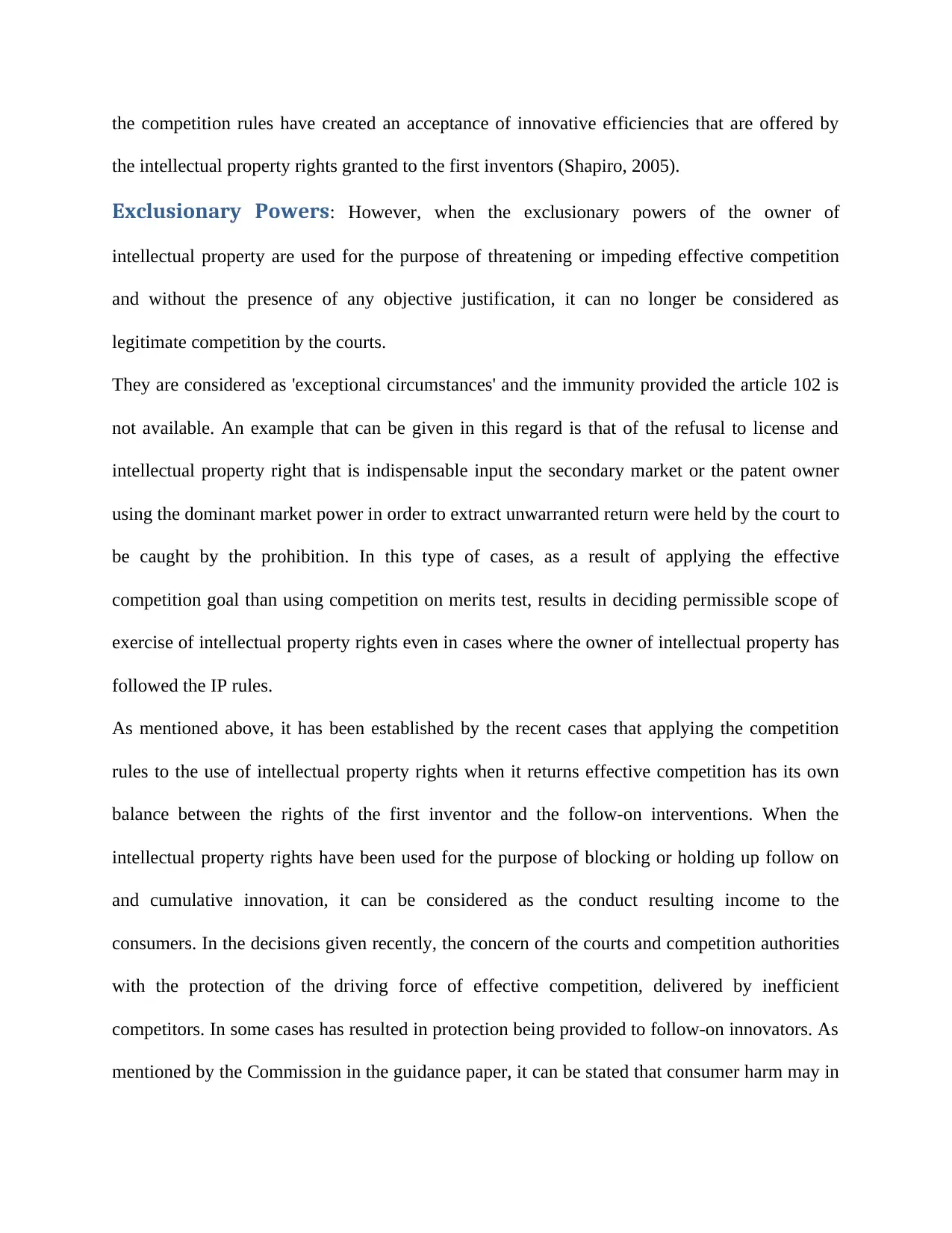
the competition rules have created an acceptance of innovative efficiencies that are offered by
the intellectual property rights granted to the first inventors (Shapiro, 2005).
Exclusionary Powers: However, when the exclusionary powers of the owner of
intellectual property are used for the purpose of threatening or impeding effective competition
and without the presence of any objective justification, it can no longer be considered as
legitimate competition by the courts.
They are considered as 'exceptional circumstances' and the immunity provided the article 102 is
not available. An example that can be given in this regard is that of the refusal to license and
intellectual property right that is indispensable input the secondary market or the patent owner
using the dominant market power in order to extract unwarranted return were held by the court to
be caught by the prohibition. In this type of cases, as a result of applying the effective
competition goal than using competition on merits test, results in deciding permissible scope of
exercise of intellectual property rights even in cases where the owner of intellectual property has
followed the IP rules.
As mentioned above, it has been established by the recent cases that applying the competition
rules to the use of intellectual property rights when it returns effective competition has its own
balance between the rights of the first inventor and the follow-on interventions. When the
intellectual property rights have been used for the purpose of blocking or holding up follow on
and cumulative innovation, it can be considered as the conduct resulting income to the
consumers. In the decisions given recently, the concern of the courts and competition authorities
with the protection of the driving force of effective competition, delivered by inefficient
competitors. In some cases has resulted in protection being provided to follow-on innovators. As
mentioned by the Commission in the guidance paper, it can be stated that consumer harm may in
the intellectual property rights granted to the first inventors (Shapiro, 2005).
Exclusionary Powers: However, when the exclusionary powers of the owner of
intellectual property are used for the purpose of threatening or impeding effective competition
and without the presence of any objective justification, it can no longer be considered as
legitimate competition by the courts.
They are considered as 'exceptional circumstances' and the immunity provided the article 102 is
not available. An example that can be given in this regard is that of the refusal to license and
intellectual property right that is indispensable input the secondary market or the patent owner
using the dominant market power in order to extract unwarranted return were held by the court to
be caught by the prohibition. In this type of cases, as a result of applying the effective
competition goal than using competition on merits test, results in deciding permissible scope of
exercise of intellectual property rights even in cases where the owner of intellectual property has
followed the IP rules.
As mentioned above, it has been established by the recent cases that applying the competition
rules to the use of intellectual property rights when it returns effective competition has its own
balance between the rights of the first inventor and the follow-on interventions. When the
intellectual property rights have been used for the purpose of blocking or holding up follow on
and cumulative innovation, it can be considered as the conduct resulting income to the
consumers. In the decisions given recently, the concern of the courts and competition authorities
with the protection of the driving force of effective competition, delivered by inefficient
competitors. In some cases has resulted in protection being provided to follow-on innovators. As
mentioned by the Commission in the guidance paper, it can be stated that consumer harm may in
⊘ This is a preview!⊘
Do you want full access?
Subscribe today to unlock all pages.

Trusted by 1+ million students worldwide
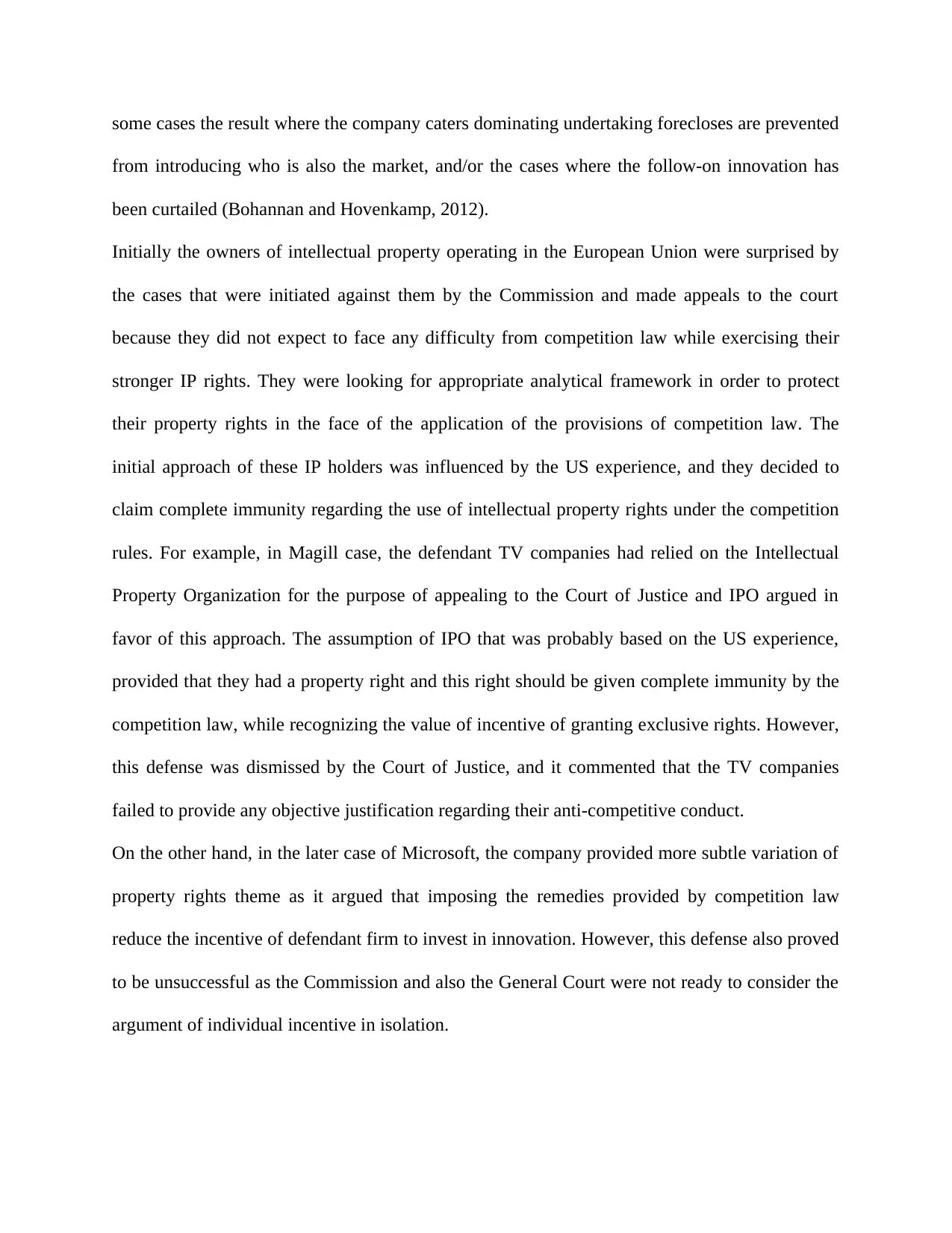
some cases the result where the company caters dominating undertaking forecloses are prevented
from introducing who is also the market, and/or the cases where the follow-on innovation has
been curtailed (Bohannan and Hovenkamp, 2012).
Initially the owners of intellectual property operating in the European Union were surprised by
the cases that were initiated against them by the Commission and made appeals to the court
because they did not expect to face any difficulty from competition law while exercising their
stronger IP rights. They were looking for appropriate analytical framework in order to protect
their property rights in the face of the application of the provisions of competition law. The
initial approach of these IP holders was influenced by the US experience, and they decided to
claim complete immunity regarding the use of intellectual property rights under the competition
rules. For example, in Magill case, the defendant TV companies had relied on the Intellectual
Property Organization for the purpose of appealing to the Court of Justice and IPO argued in
favor of this approach. The assumption of IPO that was probably based on the US experience,
provided that they had a property right and this right should be given complete immunity by the
competition law, while recognizing the value of incentive of granting exclusive rights. However,
this defense was dismissed by the Court of Justice, and it commented that the TV companies
failed to provide any objective justification regarding their anti-competitive conduct.
On the other hand, in the later case of Microsoft, the company provided more subtle variation of
property rights theme as it argued that imposing the remedies provided by competition law
reduce the incentive of defendant firm to invest in innovation. However, this defense also proved
to be unsuccessful as the Commission and also the General Court were not ready to consider the
argument of individual incentive in isolation.
from introducing who is also the market, and/or the cases where the follow-on innovation has
been curtailed (Bohannan and Hovenkamp, 2012).
Initially the owners of intellectual property operating in the European Union were surprised by
the cases that were initiated against them by the Commission and made appeals to the court
because they did not expect to face any difficulty from competition law while exercising their
stronger IP rights. They were looking for appropriate analytical framework in order to protect
their property rights in the face of the application of the provisions of competition law. The
initial approach of these IP holders was influenced by the US experience, and they decided to
claim complete immunity regarding the use of intellectual property rights under the competition
rules. For example, in Magill case, the defendant TV companies had relied on the Intellectual
Property Organization for the purpose of appealing to the Court of Justice and IPO argued in
favor of this approach. The assumption of IPO that was probably based on the US experience,
provided that they had a property right and this right should be given complete immunity by the
competition law, while recognizing the value of incentive of granting exclusive rights. However,
this defense was dismissed by the Court of Justice, and it commented that the TV companies
failed to provide any objective justification regarding their anti-competitive conduct.
On the other hand, in the later case of Microsoft, the company provided more subtle variation of
property rights theme as it argued that imposing the remedies provided by competition law
reduce the incentive of defendant firm to invest in innovation. However, this defense also proved
to be unsuccessful as the Commission and also the General Court were not ready to consider the
argument of individual incentive in isolation.
Paraphrase This Document
Need a fresh take? Get an instant paraphrase of this document with our AI Paraphraser
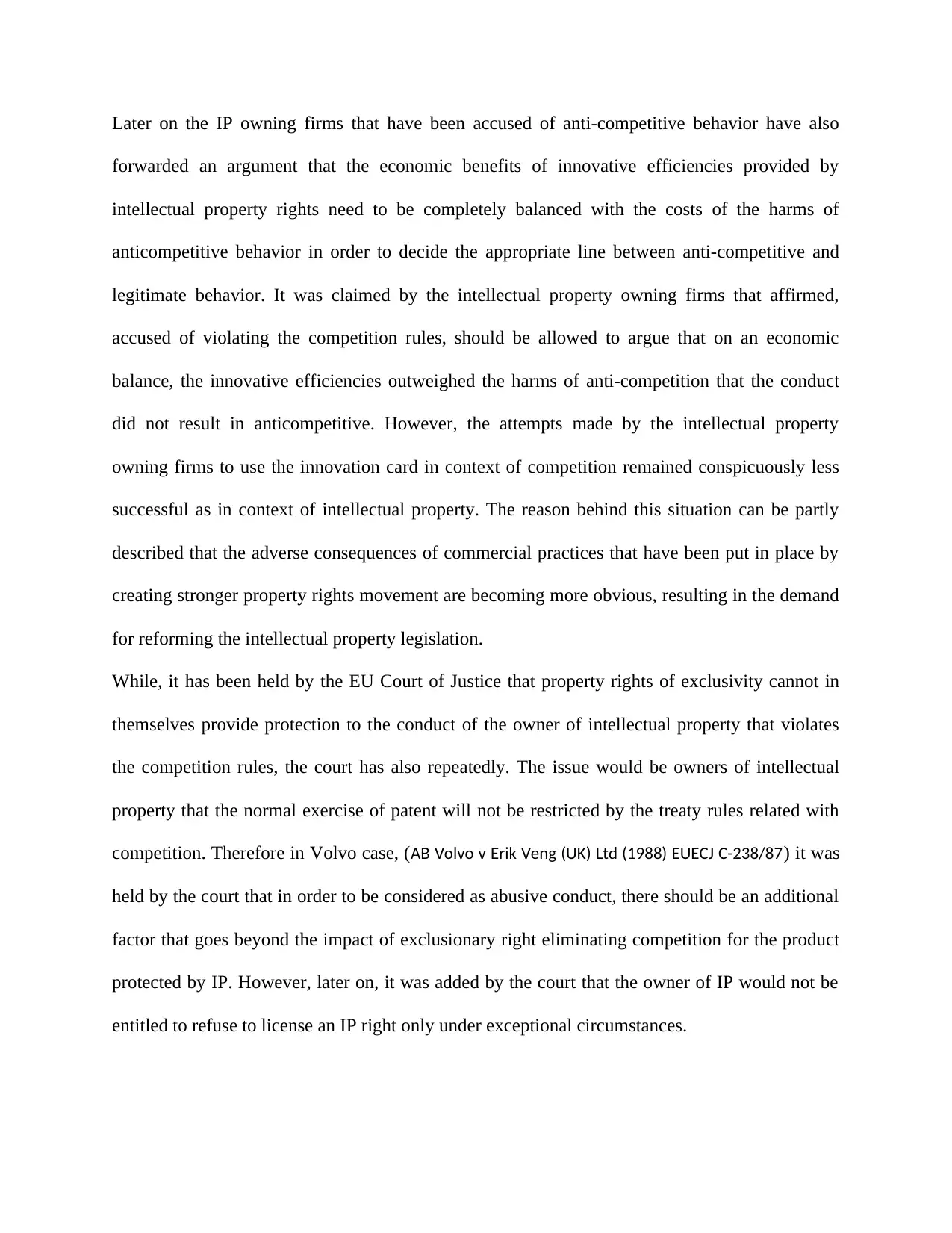
Later on the IP owning firms that have been accused of anti-competitive behavior have also
forwarded an argument that the economic benefits of innovative efficiencies provided by
intellectual property rights need to be completely balanced with the costs of the harms of
anticompetitive behavior in order to decide the appropriate line between anti-competitive and
legitimate behavior. It was claimed by the intellectual property owning firms that affirmed,
accused of violating the competition rules, should be allowed to argue that on an economic
balance, the innovative efficiencies outweighed the harms of anti-competition that the conduct
did not result in anticompetitive. However, the attempts made by the intellectual property
owning firms to use the innovation card in context of competition remained conspicuously less
successful as in context of intellectual property. The reason behind this situation can be partly
described that the adverse consequences of commercial practices that have been put in place by
creating stronger property rights movement are becoming more obvious, resulting in the demand
for reforming the intellectual property legislation.
While, it has been held by the EU Court of Justice that property rights of exclusivity cannot in
themselves provide protection to the conduct of the owner of intellectual property that violates
the competition rules, the court has also repeatedly. The issue would be owners of intellectual
property that the normal exercise of patent will not be restricted by the treaty rules related with
competition. Therefore in Volvo case, (AB Volvo v Erik Veng (UK) Ltd (1988) EUECJ C-238/87) it was
held by the court that in order to be considered as abusive conduct, there should be an additional
factor that goes beyond the impact of exclusionary right eliminating competition for the product
protected by IP. However, later on, it was added by the court that the owner of IP would not be
entitled to refuse to license an IP right only under exceptional circumstances.
forwarded an argument that the economic benefits of innovative efficiencies provided by
intellectual property rights need to be completely balanced with the costs of the harms of
anticompetitive behavior in order to decide the appropriate line between anti-competitive and
legitimate behavior. It was claimed by the intellectual property owning firms that affirmed,
accused of violating the competition rules, should be allowed to argue that on an economic
balance, the innovative efficiencies outweighed the harms of anti-competition that the conduct
did not result in anticompetitive. However, the attempts made by the intellectual property
owning firms to use the innovation card in context of competition remained conspicuously less
successful as in context of intellectual property. The reason behind this situation can be partly
described that the adverse consequences of commercial practices that have been put in place by
creating stronger property rights movement are becoming more obvious, resulting in the demand
for reforming the intellectual property legislation.
While, it has been held by the EU Court of Justice that property rights of exclusivity cannot in
themselves provide protection to the conduct of the owner of intellectual property that violates
the competition rules, the court has also repeatedly. The issue would be owners of intellectual
property that the normal exercise of patent will not be restricted by the treaty rules related with
competition. Therefore in Volvo case, (AB Volvo v Erik Veng (UK) Ltd (1988) EUECJ C-238/87) it was
held by the court that in order to be considered as abusive conduct, there should be an additional
factor that goes beyond the impact of exclusionary right eliminating competition for the product
protected by IP. However, later on, it was added by the court that the owner of IP would not be
entitled to refuse to license an IP right only under exceptional circumstances.
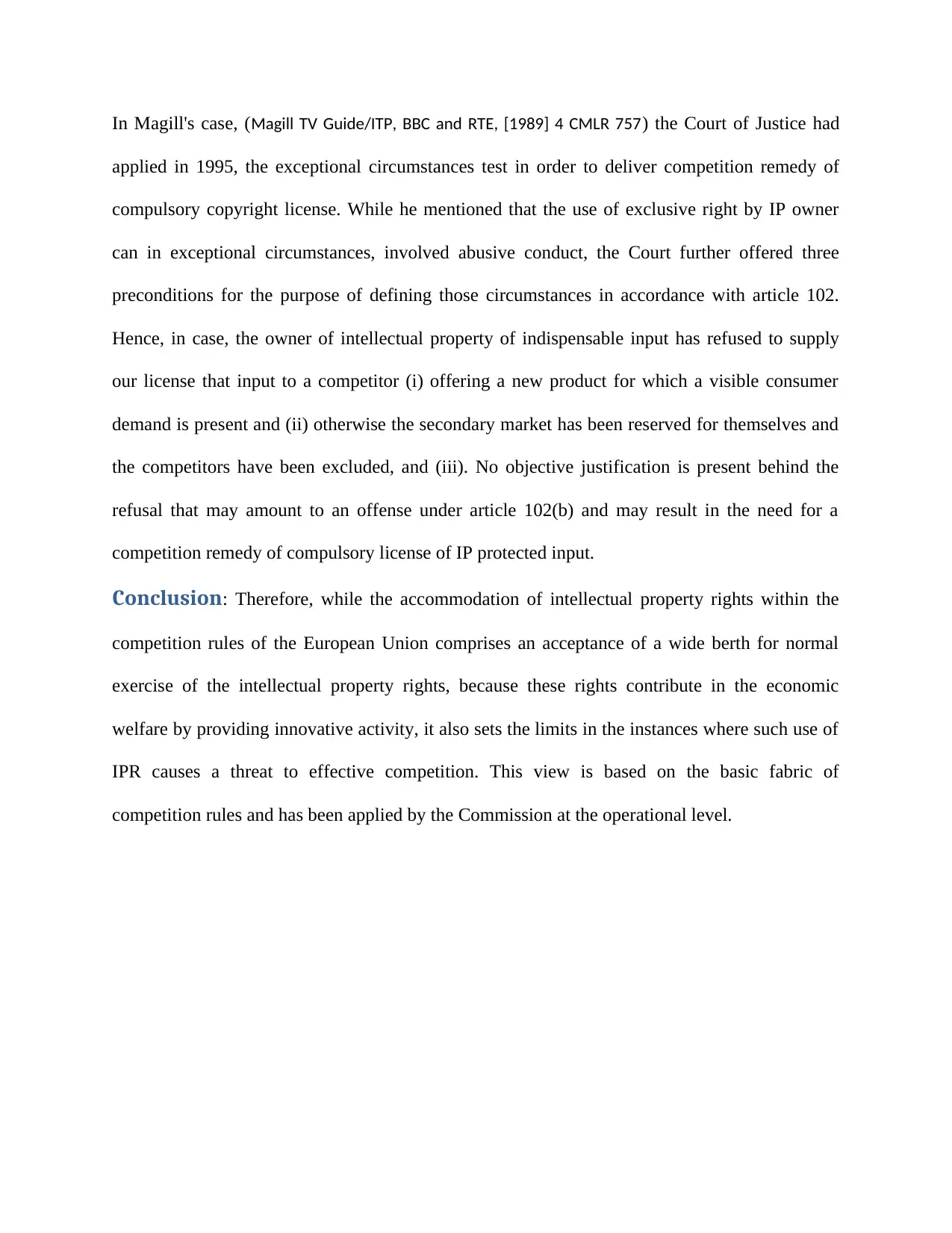
In Magill's case, (Magill TV Guide/ITP, BBC and RTE, [1989] 4 CMLR 757) the Court of Justice had
applied in 1995, the exceptional circumstances test in order to deliver competition remedy of
compulsory copyright license. While he mentioned that the use of exclusive right by IP owner
can in exceptional circumstances, involved abusive conduct, the Court further offered three
preconditions for the purpose of defining those circumstances in accordance with article 102.
Hence, in case, the owner of intellectual property of indispensable input has refused to supply
our license that input to a competitor (i) offering a new product for which a visible consumer
demand is present and (ii) otherwise the secondary market has been reserved for themselves and
the competitors have been excluded, and (iii). No objective justification is present behind the
refusal that may amount to an offense under article 102(b) and may result in the need for a
competition remedy of compulsory license of IP protected input.
Conclusion: Therefore, while the accommodation of intellectual property rights within the
competition rules of the European Union comprises an acceptance of a wide berth for normal
exercise of the intellectual property rights, because these rights contribute in the economic
welfare by providing innovative activity, it also sets the limits in the instances where such use of
IPR causes a threat to effective competition. This view is based on the basic fabric of
competition rules and has been applied by the Commission at the operational level.
applied in 1995, the exceptional circumstances test in order to deliver competition remedy of
compulsory copyright license. While he mentioned that the use of exclusive right by IP owner
can in exceptional circumstances, involved abusive conduct, the Court further offered three
preconditions for the purpose of defining those circumstances in accordance with article 102.
Hence, in case, the owner of intellectual property of indispensable input has refused to supply
our license that input to a competitor (i) offering a new product for which a visible consumer
demand is present and (ii) otherwise the secondary market has been reserved for themselves and
the competitors have been excluded, and (iii). No objective justification is present behind the
refusal that may amount to an offense under article 102(b) and may result in the need for a
competition remedy of compulsory license of IP protected input.
Conclusion: Therefore, while the accommodation of intellectual property rights within the
competition rules of the European Union comprises an acceptance of a wide berth for normal
exercise of the intellectual property rights, because these rights contribute in the economic
welfare by providing innovative activity, it also sets the limits in the instances where such use of
IPR causes a threat to effective competition. This view is based on the basic fabric of
competition rules and has been applied by the Commission at the operational level.
⊘ This is a preview!⊘
Do you want full access?
Subscribe today to unlock all pages.

Trusted by 1+ million students worldwide
1 out of 14
Related Documents
Your All-in-One AI-Powered Toolkit for Academic Success.
+13062052269
info@desklib.com
Available 24*7 on WhatsApp / Email
![[object Object]](/_next/static/media/star-bottom.7253800d.svg)
Unlock your academic potential
Copyright © 2020–2025 A2Z Services. All Rights Reserved. Developed and managed by ZUCOL.





